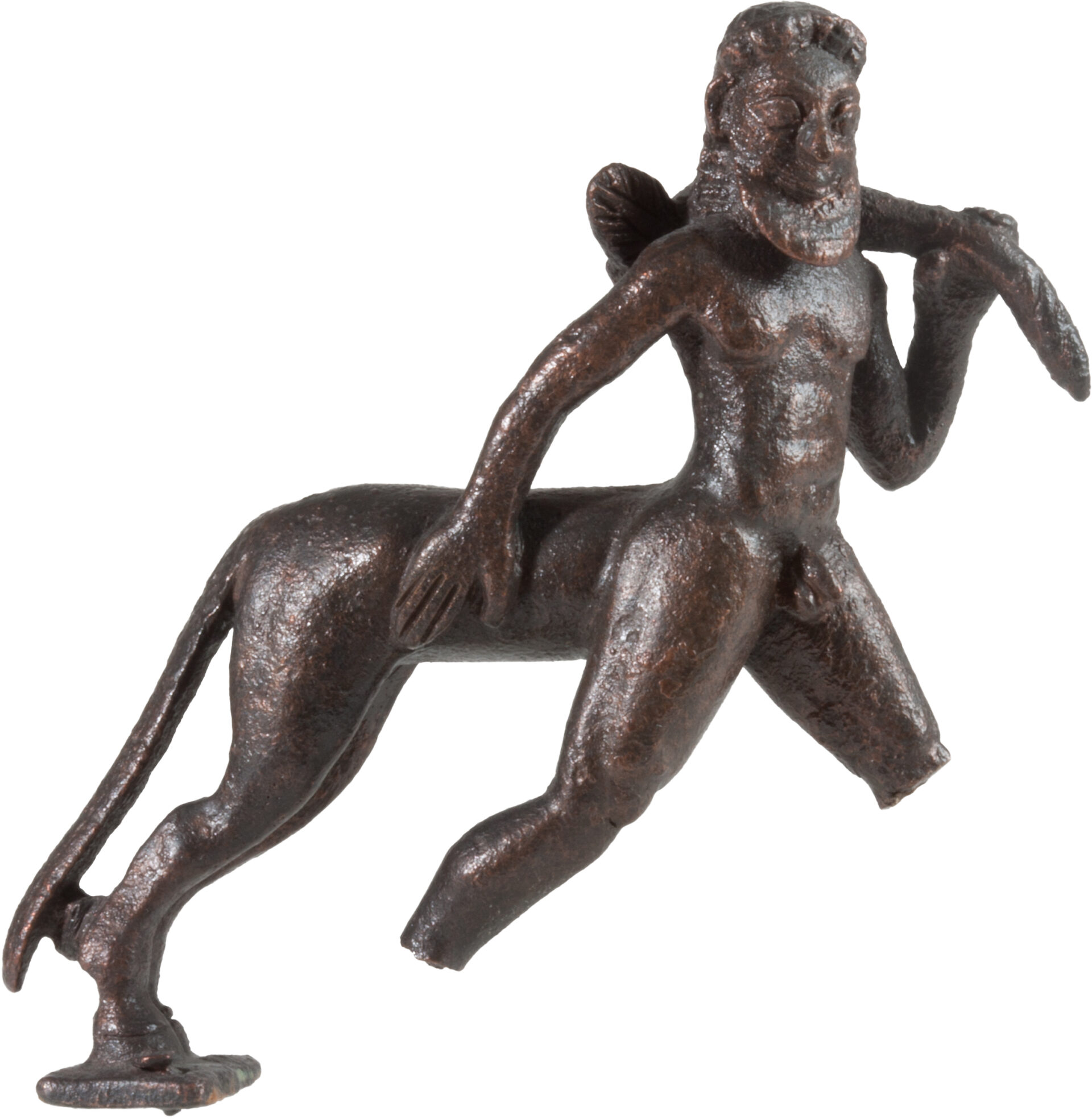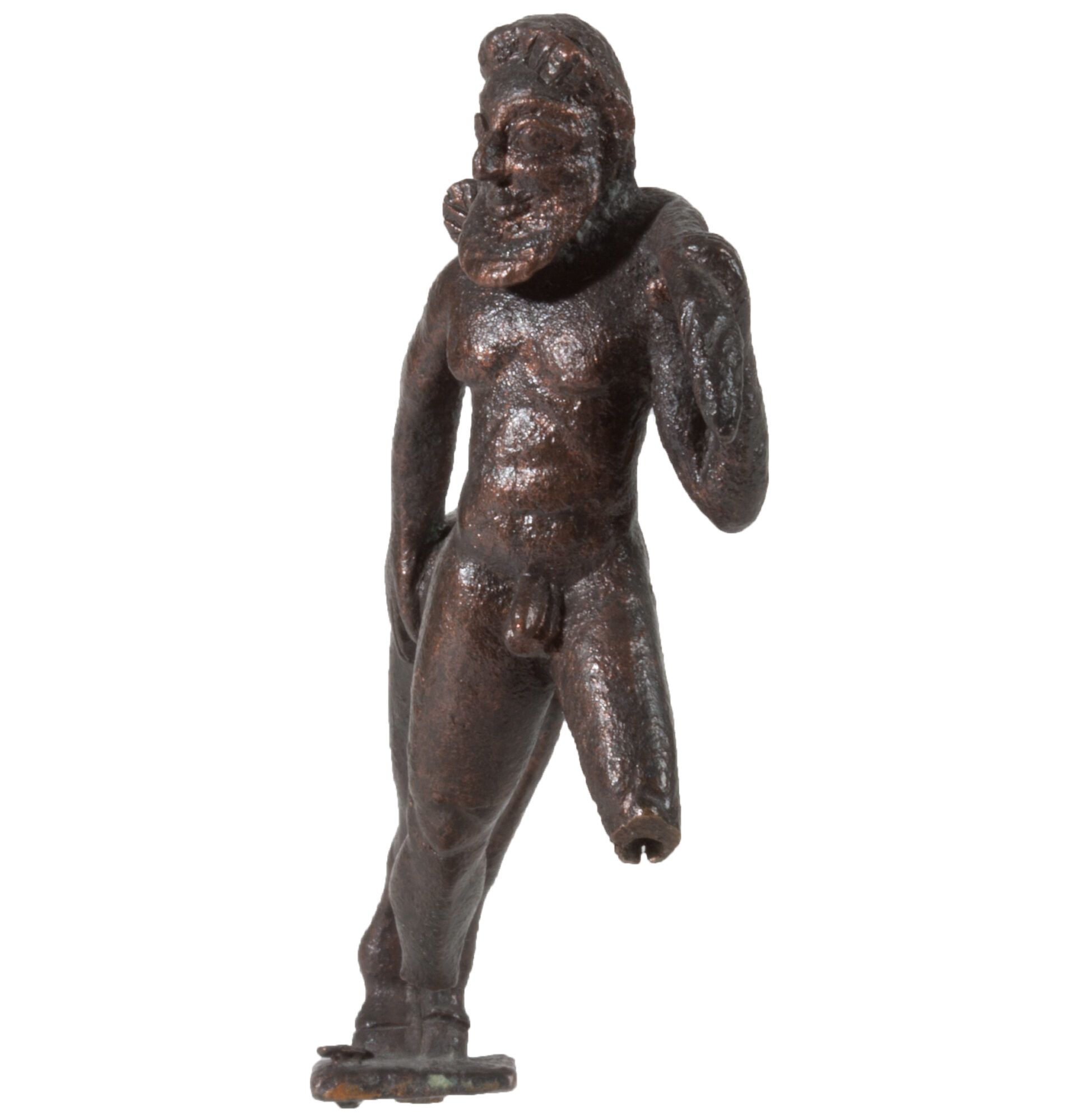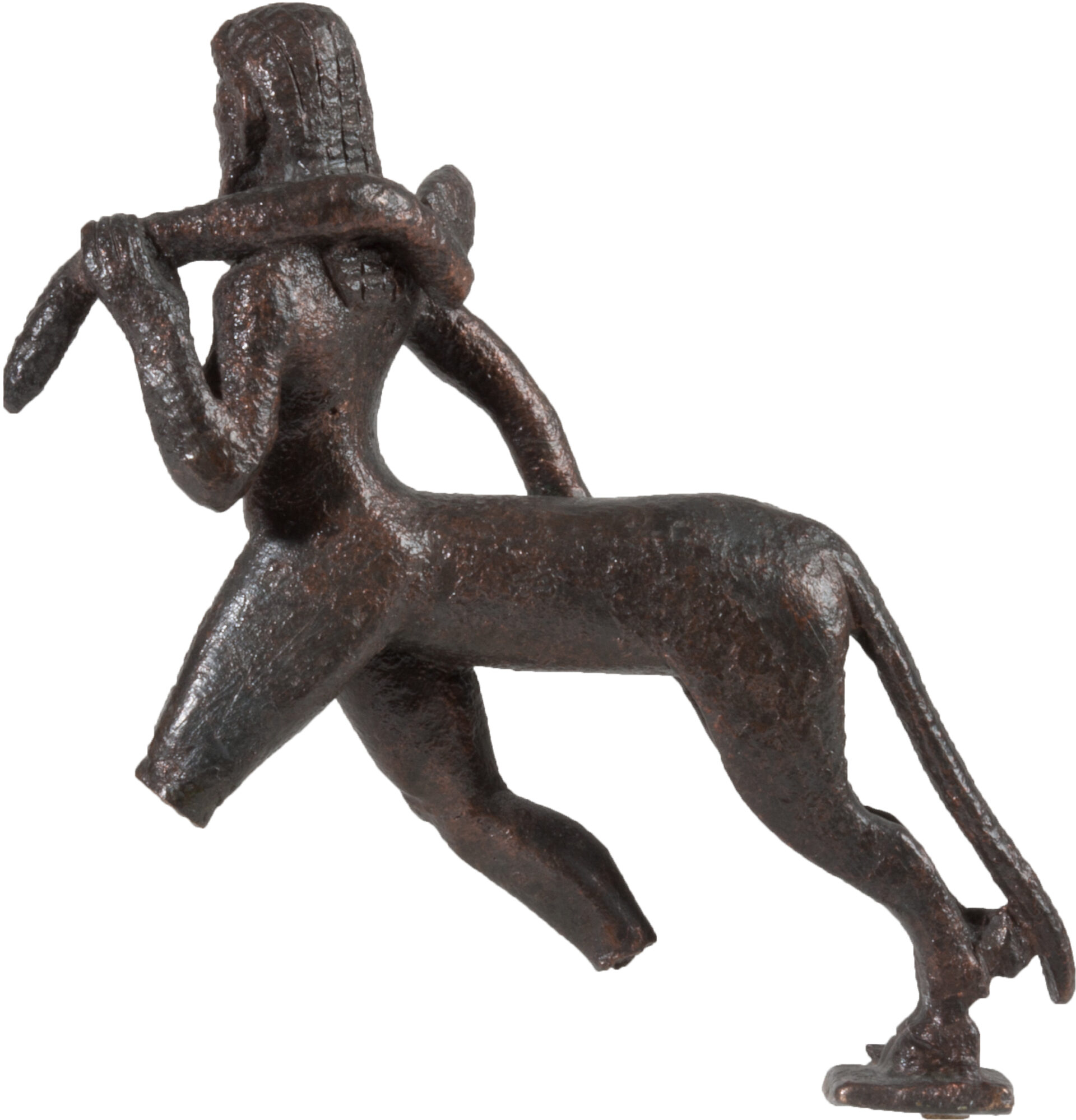Exhibit of the month
That monstrous host of double form, man joined to steed….[1]
Bronze Centaur figurine
National Archaeological Museum
Metalwork Collection, inv. no. X 6680
Provenance: Acropolis of Athens
Dimensions: Height: 6.8 cm., Length: 6.5 cm.
Date: 550-525 BC.
Display location: Room 37a, Showcase 40
The bronze cast figurine depicts a Centaur with a naked human body, to the buttocks of which joins the rear half of a horse’s body. The figure appears to be walking in a calm way with the front legs in wide stride and the hind ones joined as if galloping. The face enlivens by the “archaic smile” and the huge unnaturally protruding eyes. His long hair falls on the back in a single mass with incised locks, while the branch in his left hand implies his involvement in a fight, according to the habit of Centaurs[2]. The figurine was probably a decorative attachment of a lost tripod stand, dedicated to the sanctuary on the Acropolis of Athens and created in a Laconian workshop of the Archaic Period[3]. During the 6th c. BC. the artists used to borrow traits from the Silen’s figure, such as the flattened nose, the long beard, the baldness and the horse’s ears, in order to render a fierce figure of Centaur. Over the course of time, the beastly face sweetens and the Centaur acquires human characteristics. Gradually the Centaurs are connected thematically with Dionysus, Eros, banquets and music, and never cease to be a source of inspiration in art.
The Centaurs, half human, half horse, are among the strangest creatures created by the ancient Greek imagination. From the union of the king of the Lapiths Ixion with Nefele, a cloud made into the likeness of Hera, the first Centaur was born. The latter mated with the mares of Mount Pelion and so emerged the tribe of Centaurs. Most of them lived in the forests of Pelion; they were unrestrained like the forces of nature, aggressive, ready for riots and quarrels, armed with branches, tree-trunks, stones and rocks. They used to eat raw meat, drink wine, get drunk and behave badly. On the other hand, there were bright exceptions among the Centaurs, such as Chiron who was a connoisseur of the healing properties of the plants, an excellent hunter, as well as a healer and a teacher of gods and heroes[4]. With their image and their actions the Centaurs symbolize the duality of human nature and reveal the lower instincts that coexist with the high spiritual values of the human beings.
In most of the myths, the Centaurs got involved in unjust and irrational attacks, which resulted in their crashing defeat, as happened in the Thessalian Centauromachy[5], in the fight of Heracles with the Centaurs at Pholoe[6] as well as in the incident with Nessos[7]. Centauromachy reflects man’s struggle against the wild elements of nature and his personal fight to keep up with moderation and sense. In a different context, Centauromachy symbolizes the conflict of the civilized Greeks against the barbarians.
[1] διφυῆ τ᾽ ἄμικτον ἱπποβάμονα στρατὸν
θηρῶν, ὑβριστήν, ἄνομον, ὑπέροχον βίᾳ,
(that monstrous host of double form, man joined to steed, a race
with whom none may commune, violent, lawless, of surpassing might)
Sophocles, Trachiniae, lines 1095-1096
(English translation: http://classics.mit.edu/Sophocles/trachinae.pl.txt)
[2] The iconographic type of the Acropolis figurine with full human body, protrusion of an animal body from the buttocks and a branch in the hand, appeared in the 10th c. B.C. The type of Centaur with a human torso and a horse body develops in the middle of the 7th c. BC. and gradually predominates.
[3] In the middle of the 5th c. BC. Pheidias would choose the theme of the Thessalian Centauromachy, in which the mythical king of Athens, Theseus, took part, to decorate the metopes on the south side of the Parthenon.
[4] He taught Asklepios, Jason, Hercules, Peleus, Achilles, Dioskouroi and many others. His human nature has been highlightened in art, where Chiron is almost always depicted dressed.
[5] The Thessalian Centauromachy was the mythical battle between the Centaurs and the Lapiths. During the wedding feast of Hippodameia and Peirithoos, king of Lapiths, the Centaur Eurytion, relative of the groom, got drunk and tried to kidnap the bride. The heroes-guests, including Theseus, got angry, cut off Eurytion’s nose and ears and drove him out of the palace (Hom. Od. 21, 295-303). The Centaurs attacked the guests, but the heroes “fought with the mountain-dwelling centaurs and they destroyed them terribly” (Hom. Il. 1, 268).
[6] In the forest of Pholoe on the borders between Arkadia and Elis, the Centaur Pholos hosted Hercules, who was there chasing the Erymanthios Boar, in the course of his fourth Labour. The civilized Pholos offered the hero sweet wine, a gift from Dionysus. The smell of the wine attracted the Centaurs of the area, who tried to steal it, but Hercules chased them, reaching Cape Maleas, at the southern end of the Peloponnese.
[7] The Centaur Nessos tried to kidnap Hercules’ wife, Deianeira, but the hero killed him. The wicked Centaur, shortly before his death, secured his revenge: he advised Deianeira, if she would ever suspect that the hero was cheating on her, to prepare a love trap, smearing with the Centaur’s blood a chiton of Hercules. As time went by, Deianeira, in the face of Iole’s threat, followed Nessos’ advice. The chiton with the poisoned blood stuck to the hero’s flesh, causing him horrible pains, from which he escaped by self-immolation.
Alexandra Chatzipanagiotou
BIBLIOGRAPHY
Herfort-Koch, M., Archaische Bronzeplastik Lakoniens, Münster 1986, K 155, 61-62, 96,121.
Κακριδής, Ι.Θ. (επιμ.), Ελληνική Μυθολογία, Τόμος 3: Οι Ήρωες. Τοπικές Παραδόσεις, Αθήνα 1986, 113-117.
Lexicon Iconographicum Mythologiae Classicae VIII (1997), s.v. Kentauroi et Kentaurides, 676, no. 39, pl. 418 (L. Marangou). For Centaurs in general see: 671 -721 (S. Drougou, M. Leventopoulou et al.)
Rolley, Cl., Les Bronzes Grecs, Fribourg 1983, 108, 110, εικ. 90.
Schiffler, B., Die Typologie des Kentauren in der antiken Kunst vom 10.bis zum Ende des 4. Jhs. v. Chr., Frankfurt – Bern 1976, 154-155, 320 V15.
Stibbe, C. M., Agalmata. Studien zur griechisch-archaischen Bronzekunst, Leuven – Paris 2006, 298.
Τσαγκάρη, Δ. (επιμ.), Μύθος και νόμισμα, Κατάλογος έκθεσης, Εθνικό Αρχαιολογικό Μουσείο – Νομισματικό Μουσείο, 15 Απριλίου – 27 Νοεμβρίου 2011, Αθήνα 2011, 119, αρ. κατ. 248 (Ν. Παλαιοκρασσά).




